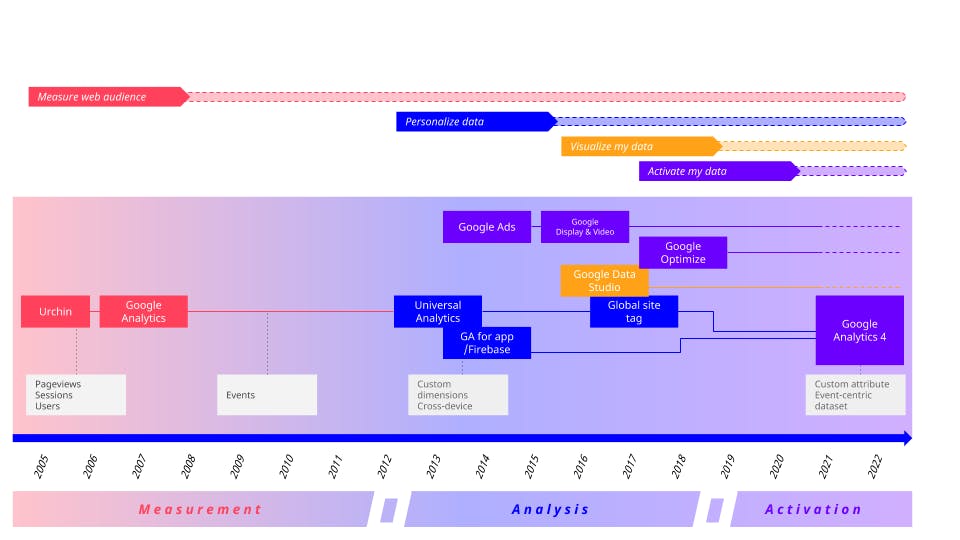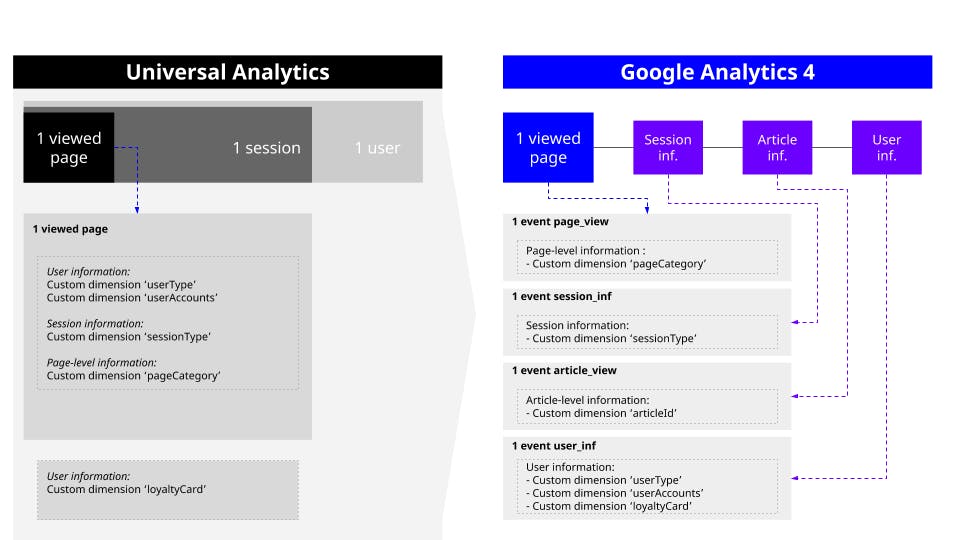2021-01-25
Google Analytics is no more. Long live GA4
After eight years at the forefront of first-party data processing, the Google Analytics Universal platform has given way to its successor: Google Analytics 4. The arrival of GA 4 – initially called “App + Web” – marks a momentous turning point in data-driven marketing.
The new platform will radically change data processing, from collection to activation. The switch also signals a much-needed adjustment to tectonic shifts in user behavior, market player policies, and legislative frameworks. Google’s pivot also fits the larger business context, with brands forced into accelerated digital transformations to data-based structures, decision-making, and processes – also known to some as data-driven steering.
It’s big news.
Jellyfish has been preparing for this announcement for more than a year. Here’s our perspective on why GA 4 is happening, what immediate changes it’ll bring, and what marketers can do now to prepare for its adoption.
Why Google Analytics Universal is riding off into the sunset
The Google Analytics Universal era has been great – but the platform’s limitations have rendered it increasingly inadequate at keeping up with major evolutions in the digital marketing ecosystem.
Due to changes in media consumption habits, modern customers have come to expect a homogenous experience, marked by relevant brand interactions in a broader context of runaway over-solicitation. These same customers demand to see their online privacy respected and flock to digital experiences that can better deliver on that promise.
This ongoing development strained Google Analytics Universal’s ability to adequately collect data. With the disappearance of the cookie and the rise of walled gardens, user data collection now relies on consent and suffers from differing technological limitations depending on point of origin, and therefore becomes less comprehensive and homogeneous.
But Google Analytics Universal also fell short of delivering to new approaches to web analytics practices, as distinguished by the following successive eras in Google’s approach:
- The Era of Measurement: basic and pragmatic, this was marked by the initial goal of measuring audiences, was superseded by…
- The Era of Analysis: marked by custom data collection, static and dynamic reporting, and the dawn of Firebase, driven by the goal of evaluating performance, has now given way to…
- The Era of Activation: the current state of analysis is marked by interconnectivity – of tools such as Google Ads, Optimize, and Firebase AB – with the goal of making data into a lever for ROI.
GA 4 was built to serve the analytical needs of this third era, where the conditions and priorities for data collection, analysis, and activation must change in accordance with evolving goals. This newest era emphasizes interconnections that enable machine learning, audience-based vision, and more direct data activation.

The limitations of Google Analytics Universal helped reveal a new truth about first-part data – it can only create value for brands under key conditions:
- When collected and structured with the aim of building a single, short-axis linking media, onsite, and offsite navigation;
- When it can be transformed and sublimated to compensate for the loss of information caused by privacy; and
- When its collection aids user-based vision in a world that will soon be cookieless.
The new normal requires data collection methodology that’s flexible, untethered, and actionable in real-time – allowing marketers to properly value data assets in an ecosystem where privacy and data quality are core issues.
The prior system wasn’t up to that new task, while GA 4 provides access to increasingly hybrid data.
Issues addressed by Google Analytics 4
As GA 4 becomes the standard platform for analysis, its impact will evolve. Indirect implications will be far-reaching and alter strategic decision-making, but the first exciting step in GA 4’s widespread adoption involves testing out new features available right out of the box.
The following practices will be better enabled by the new software:
1. Data collection for a wider scope of interests
To build a more unified view of collection and performance, GA 4 natively integrates multi-platform metrics. It also automatically standardizes naming conventions – that sound you hear is your analytics team cheering – which enables pre-built reports based on machine learning to gather more integrated insights more easily.
For example, the data engineering necessary for analysis such as churn probability is now greatly reduced. And as these insight types penetrate the digital marketing ecosystem, we can expect further layering of increasingly vertical reporting to reveal ever more powerful learnings.

2. A more agile exploration of data
While GA 4 has to integrate pre-built reports, it stands out from its predecessors in that it does so in order to build new ones on the fly. This new data exploration functionality will make data analysis and discovery more readily comprehensible, and reporting more responsive to inquiry. New features include customizable, audience building tunnels and an exploration module, both accessible in Data Studio.
GA 4 helps to fragment and multiply data access across an analytics ecosystem with refined roles for each tool. GA 4 ups the ante as a “basic” exploration and analysis interface, while Data Studio organizes outputs as a dashboard and sharing tool, and BigQuery layers over the top as an advanced analysis engine.
3. Increasingly robust integration capabilities
While GA 4 allows on-the-fly exploration and analysis, it will also serve as a hub between data and activation tools.
It therefore logically integrates a link with Google Ads and Big Query – now possible for the GA free version. But more direct linkages within the Google suite are expected in the future, culminating in YouTube integration that will provide an integrated view of conversions.
4. “Privacy by design” data filtration
In order to meet present and future user privacy requirements, GA 4 has streamlined the elimination of problematic user data capture.
Data deletion is native, which allows marketers to delete unwanted parameters such as name, email, etc. from the collection process. Additional tools such as consent mode will surely be integrated into the interface in the near future. GA 4 was also built to address the needs of a cookieless future, centering the role of User ID.
5. A centralized role for audiences
In rethinking the audience system, Google has restructured part of the integration with its other tools to be even more activation-centric.
The audience creation system, a cornerstone and direct link with Google Ads is now much more flexible. GA 4 was designed for more flexible and media-centric use, offering an attribution window, view of overlap between audiences, cross-platform attribution, and trigger signals when entering an audience.
6. A redesigned collection framework
GA 4’s new collection framework is largely based on the Firebase. In a huge change from the former iteration, it is event-centric.
The GA Universal collection framework was built around the analytics platform, not usage – in essence, it collects data upon page loads, and waits for further user action to enrich it. This proved inadequate to modern analytical requirements, especially given the recent increase of SPAs (single page apps).
Contemporary user experiences involve a logical sequence of events with different timing; from page loading events to responses from content recommendation tools, to CRM callbacks, to calculations of the user score, enrichment of the navigation contexts, and more.
GA4’s event-centric collection meets the need for multi-contextual feedback on user behavior within a complete and heterogeneous ecosystem. Moving to an event-centric dataset will have far-reaching consequences. The transition represents a change of mindset at all stages of data processing (collection, analysis, activation), allowing marketers to move from a logic of “storage and analysis” of data to a logic of “reaction and creation” when faced with it.
How to get ready for Google Analytics 4
What should we do next?
Currently, GAU remains the reference analytical tool due to its maturity. GA 4 is still under development and is still limited in terms of active integrations. But the current state of the new platform does give marketers a glimpse into the analytics tool of the future, with no shortage of advantages to discover.
Taking the time to tool around with GA 4 now will give early movers a head start once implementation becomes fully feasible.
Watch this one hour webinar to find out more about getting started with Google Analytics 4.
And if you need more training, we have a Google Analytics 4 training course that will get you ahead of the curve.
Along with a team onboarding phase, marketers need to ask and answer the following questions to form the core of a migration project:
- “Does my collection allow me to create a datalake?”
- “Do I follow good naming practices?”
- “Is my collection exhaustive?”
- “Does my collection allow me to activate effective media and personalization campaigns?”
Those who can answer “yes” to the above within their current state of GAU usage will have a leg up on an effective transition to full GA 4 implementation.
In the meantime, set up dual tracking to simultaneously collect data within Google Analytics Universal and Google Analytics 4 to ensure continuity of data access and explore the new possibilities offered by GA 4.
To start a conversation about onboarding or upskilling for the transition to GA 4, reach out to Jellyfish.
